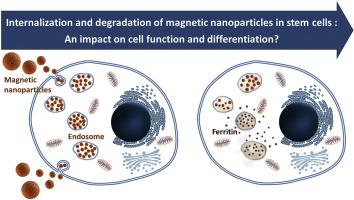Materials Today Nano ( IF 8.2 ) Pub Date : 2020-05-07 , DOI: 10.1016/j.mtnano.2020.100084 A. Van de Walle , J.E. Perez , A. Abou-Hassan , M. Hémadi , N. Luciani , C. Wilhelm

|
With advancing developments over the use of magnetic nanoparticles in biomedical engineering, and more specifically cell-based therapies, the question of their fate and impact once internalized within cells remains crucial. After highlighting the regenerative medicine applications based on magnetic nanoparticles, this review documents their potential cytotoxicity and, more importantly, underscores their valuable features for stem cell differentiation. It then focuses on the transformations magnetic nanoparticles might experience in cells, mainly consisting in their progressive degradation, and assesses the practical pitfalls related to this degradation. First, it may result in a loss of long-term theranostic potential, and second, it drives an adaptation of the cell metabolism to the released iron. Overall, this review demonstrates that magnetic nanoparticles present undeniable interest for stem cell-based biomedical applications; however, each nanoparticle/cell system must be carefully considered for a safe medical use. It also clearly demonstrates that the biodegradation of the nanoparticles and the cell response to the released iron must be systematically assessed.
中文翻译:

再生医学中的磁性纳米颗粒:它们在干细胞中的命运和影响是什么?
随着在生物医学工程中,尤其是在基于细胞的治疗中,磁性纳米颗粒的使用方面的发展,随着它们在细胞内被内化,其命运和影响的问题仍然至关重要。在重点介绍了基于磁性纳米颗粒的再生医学应用后,本综述记录了其潜在的细胞毒性,更重要的是,强调了其在干细胞分化中的宝贵功能。然后,重点研究了磁性纳米粒子在细胞中可能经历的转变,主要包括其逐步降解,并评估了与该降解有关的实际陷阱。首先,它可能导致长期的治疗诊断能力丧失,其次,它促使细胞代谢适应释放的铁。总体,这篇综述证明了磁性纳米颗粒对于基于干细胞的生物医学应用具有不可否认的兴趣。但是,为了安全的医疗用途,必须仔细考虑每个纳米颗粒/细胞系统。它还清楚地表明,必须系统地评估纳米颗粒的生物降解和细胞对释放的铁的反应。











































 京公网安备 11010802027423号
京公网安备 11010802027423号